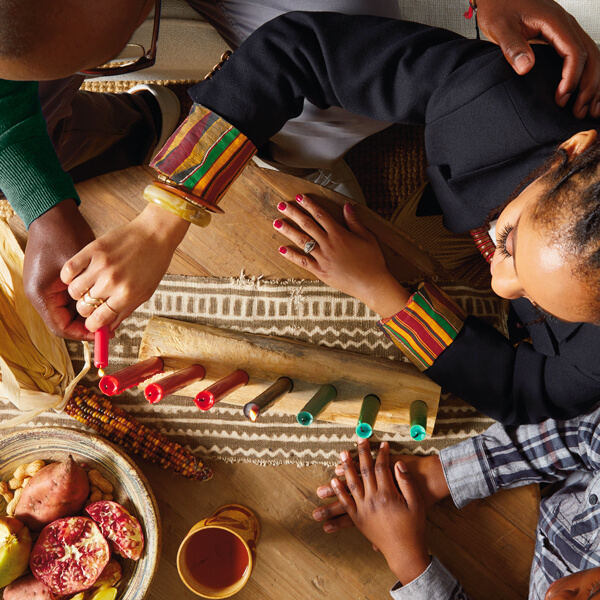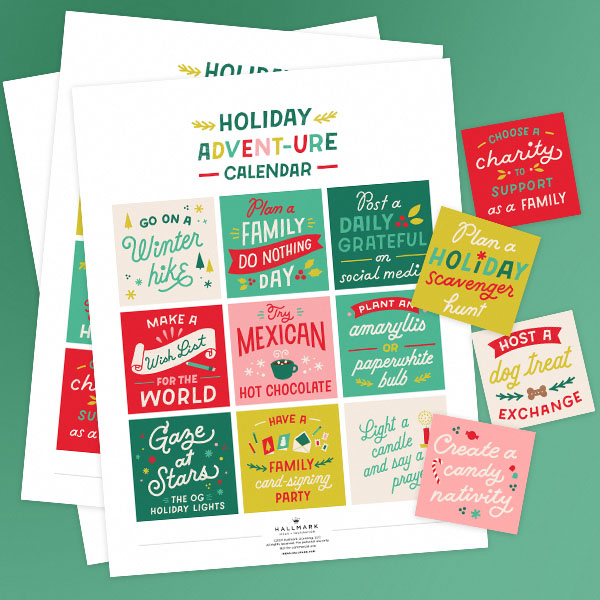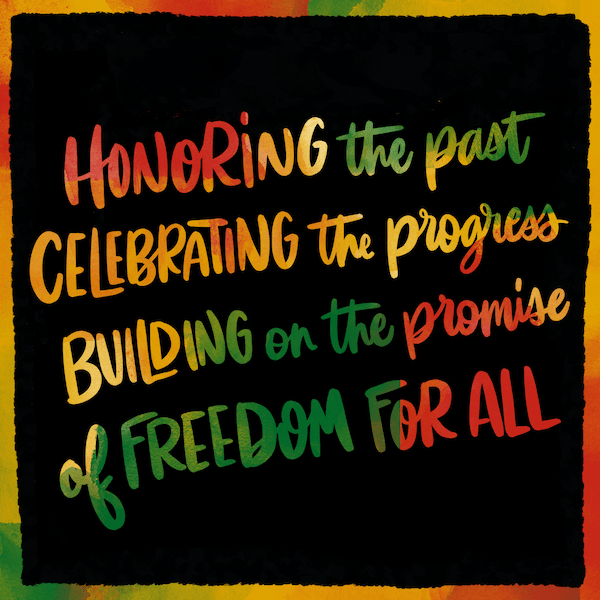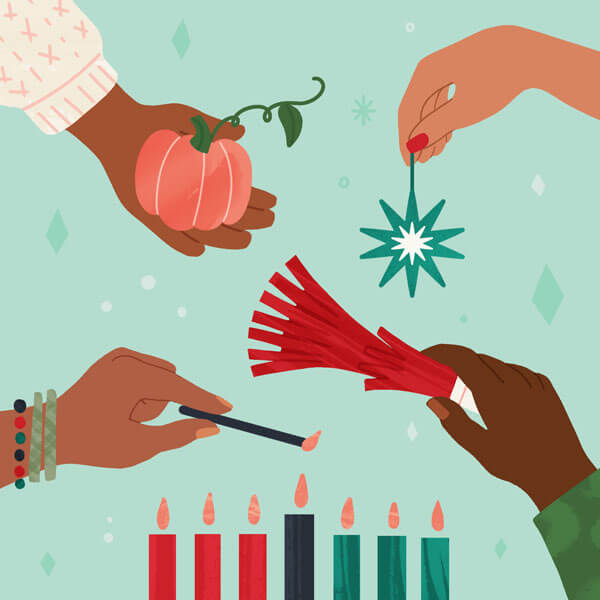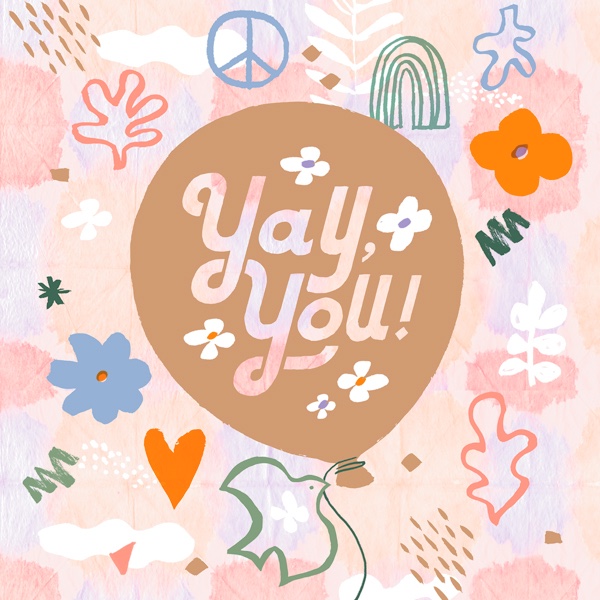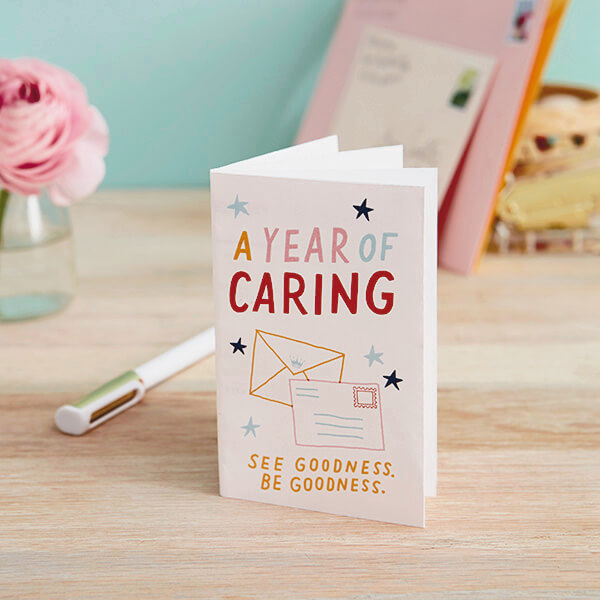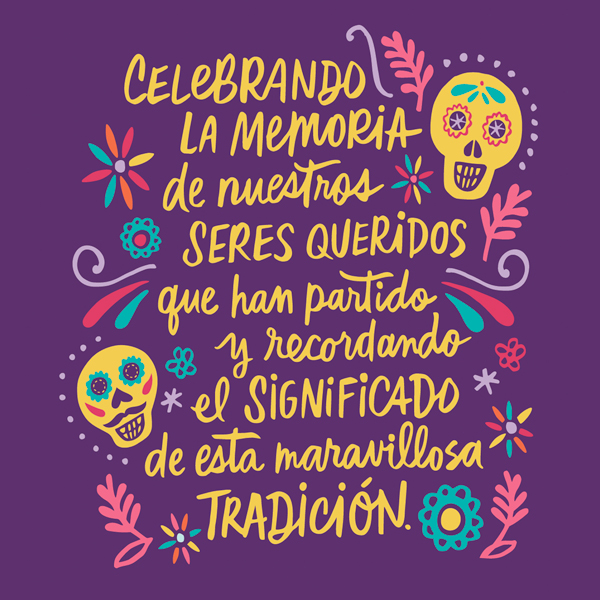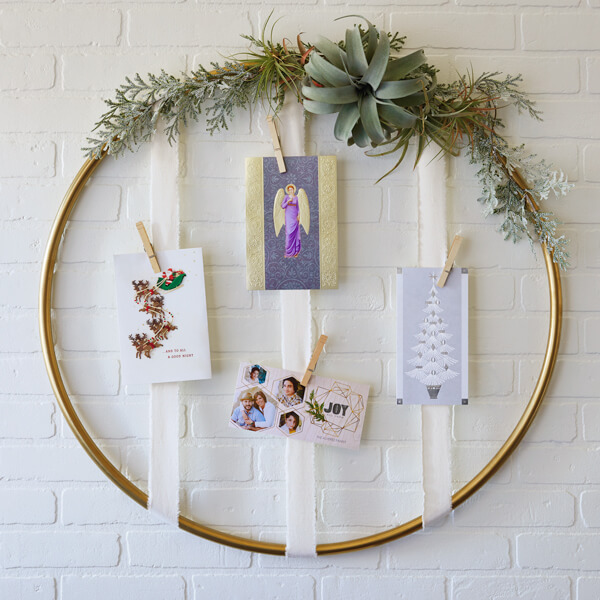Redefining Togetherness

Throughout history, during any time of struggle or uncertainty, we humans have always had one surefire way of finding our way through: We pull together to talk, plan, hug it out, work shoulder to shoulder or even just to feel the reassuring comfort of one another’s presence. Connecting with people is what we’re built for, and it genuinely helps even the most self-contained among us.
But what does togetherness look like when the best way to care for others is to stay apart?
This post is part of our Caring and Creating during Tough Times series.
Inspired? Create and share by tagging @HallmarkStores.
Luckily, we live in a time when we have more options than ever before for staying connected with everyone from our closest family and friends to outer-circle acquaintances and even strangers who could use a little light and hope.
What follows is a series of ideas for nurturing a feeling of togetherness with the people you care about, starting with the person closest in: you.
SELF-CARE: Nurturing togetherness by taking care of you
At its most basic, self-care means taking time for relaxing or enjoyable activities that recharge your batteries. Getting enough sleep and eating right are good for all of us, but beyond that, self-care takes different forms for different people. When it comes to togetherness, try to think of self-care as not only enhancing your own well-being, but also increasing your capacity to be available for friends and family when they need you. Also keep in mind that some self-care activities can be shared in person or digitally, thus turning them into together time.
To maximize your self-care right now, you may wish to think of it in terms of mind, body and spirit.
Mind
- Reading: In addition to tackling any unread books on your home shelves, consider getting on your library’s website to learn about borrowing e-books and digital audiobooks. For kids, take advantage of the many children’s authors doing online read-alouds of their works, free audio streaming of classic books, and virtual museum tours.
- Podcasts: These days, there’s a podcast for just about anything you might want to learn about. Check out podcast providers like Stitcher, Wondery, and BBC Sounds, or simply open the podcasts app on your device and search for your area of interest.
- Mind benders: Gaming, puzzles, crosswords and other brainteasers are always a good self-care idea, too, and they can turn into together time if you do them along with someone in person or over digital media.
Body
- Outdoor fitness: The nearest gym may be closed, but as long as we’re permitted to go outdoors, there are still opportunities for walking, running, cycling and other heart-pumping activities. Sunshine and fresh air can do wonders for everyone.
- Indoor fitness: If you can’t get out, make an at-home workout part of your daily routine. Both online fitness videos and workout apps are good resources for keeping kid and adult bodies moving when you’re stuck indoors.
- Food: Chances are you’re doing a lot more cooking at home. Chefs and other pros are responding by providing online recipes and resources, including lists of staples to keep on hand as much as possible. Depending on family members’ ages and abilities, include them in cooking as much as possible. You’ll be nurturing togetherness while also taking good care of yourselves.
Spirit
- Meditation: Especially if you’re coping with extreme stress due to job loss or a job that has suddenly become overwhelming, meditation has proven benefits and may be worth a try. In addition to meditation apps like Calm and Headspace, experts are also offering meditation teaching and guidance online using video meeting platforms, such as Zoom.
- Streaming worship services: As places of worship cancel in-person services, many are replacing them with weekly podcast sermons or online video worship services. Check the website of your regular place of worship, or check out one in another neighborhood, city or state to get a different spiritual perspective on what’s happening. Either way, there’s valuable togetherness in regularly connecting with a faith community.
- Journaling:Writing about your feelings and experiences can be a great way of processing complicated thoughts and emotions. Either handwritten or digital journaling works.
- Routine: Hallmark writer Mercedes notes that maintaining structure is a vital self-care practice for her and her partner: “It’s hard. For me, sticking to a routine is incredibly necessary for my mental health. We limit the amount of time we spend on the news. But I’m also being patient with myself. I don’t need to be productive 100% of the time. I can just be.”
That’s an important piece of self-care, too—give yourself permission to pause, take a deep breath, feel what you’re feeling and acknowledge that this truly is a stressful and worrisome time.
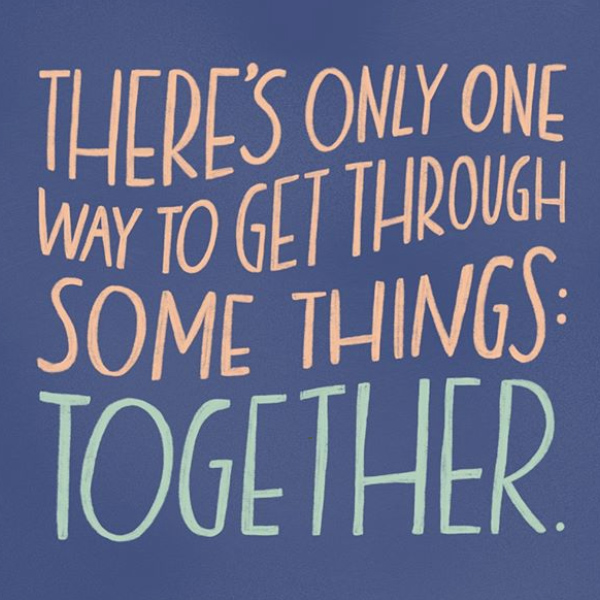
KIDS: Fostering togetherness from toddlers to teens
Kids of different ages will have varying challenges and needs during these tough times, but nurturing togetherness is vital for all of them, and many of the same tools and strategies can help, from the youngest on up.
Preschool age:
The hands-on nature of caring for little ones will continue to create an organic sense of togetherness with them. When it comes to fostering togetherness beyond your household, tap into the natural joy-spreading powers of your littles by setting up routine phone calls, FaceTime dates or video chats with their friends, your friends and extended family. Grandparents and others will love seeing their cute faces, and the good feelings will flow both ways as your kids see the smiles they’re inspiring.
If your little one isn’t dependably in the mood for a scheduled call, then take a video of them when they are in a good mood—telling a joke, singing a song, demonstrating a skill or just being adorable. Post to social media or share directly with special people they can’t see in person right now—and ask them to do the same for your little one.
Trish, a Hallmarker (yes, that’s what we call ourselves), lives in the middle of a neighborhood “bear hunt.” Folks are encouraged to put a stuffed bear in a window and post their address or block on a Facebook group. Kiddos look for the bears on family walks.
Elementary and tween:
The older end of this age group may already be adept at communicating digitally with their friend group, and it’s healthy for them to keep that up. Encourage them to also turn those skills toward staying in touch with extended family. Help and include your younger school-age kids in using video chat and other digital connecting tools, and invite extended family to think about fun things to share with school-age kids, even if it’s very simple.
Jacque, the mother of a Hallmarker, has started texting daily “letter sentences” with her kindergarten-age granddaughter. Each day, they compete to see who can come up with a sentence using the most words starting with the letter of the day. It’s the kind of thing that seems small but will undoubtedly create a sense of togetherness for the two of them—not to mention a lasting memory they’ll both cherish.
In addition, don’t forget about creating low-tech and hands-on togetherness with and for school-age kids. From crafts to music making to family game nights, it all can help bring everyone out of their rooms and closer together. Beyond your home, consider having your school-age kids do things like singing to a homebound neighbor, creating sidewalk-chalk art for passersby, or writing and mailing a card to someone who needs a day brightener.
Teens:
Teens may be grieving more than you realize as spring dances, sport seasons and graduation ceremonies are canceled. In addition, their lives are being disrupted at the exact moment many of them were starting to enjoy more freedom and mobility to go out and meet up with friends on their own. It’s dispiriting, and it’s important for the adults in their lives to honor those very real feelings of disappointment and unwelcome confinement. At the same time, it’s just as important not to let those feelings turn into endless wallowing or self-isolation.
Teens are going to benefit from self-care, routine and creating togetherness just as younger kids do. With school commutes and extracurriculars canceled, they now have time to play an online game with Uncle Joe or Skype with Nana. Remind them to do it. Added bonus: Your teen may be able to help troubleshoot issues you or family members may be having with digital connecting. Never done a Google Hangout before? Your teen can probably help you figure it out.
Beyond just tech support, teens are more emotionally and physically capable than younger kids of turning outward to think about how they can support people around them. Whether it’s donating items to a shelter or food pantry, or leaving flyers around the neighborhood offering help with yardwork or other tasks, that turning outward fosters a sense of being in this together. It also helps take teens’ minds off their own troubles.
ELDERS: Maintaining togetherness with older people you care about
Technology barriers, misinformation and the desire to maintain independence can be special challenges for older people. Stay close to them by helping out.
- Pick up the phone: Hallmark writer Courtney notes that talking on the phone is not her preferred method of communication, but she’s getting over it in the name of staying in touch right now, especially with older family. That’s a good lead to follow. Using the communication method that’s easiest for an older person is the best way to ensure a solid sense of togetherness. That said, if you can easily talk them through how to connect via video chat, by all means do. Hallmark editor Mary reported, “I’m 56 and my daughter is 28…we FaceTimed for the first time ever last night (she only lives five minutes from me). It was hilarious—both my inexperience and her amusement at it!”
- Write: Older generations also tend to be fans of handwritten notes and day-brightening cards. They’re accustomed to both sending and receiving them. If you have kids, be sure to get them in on writing to (or drawing for) older family and friends. Getting fun mail will be something to look forward to on both ends of the exchange—and it will give everyone concrete, keepable reminders of this very strange time when we all pulled together like never before. (Here are some hints from Hallmark editor Emily.)
- Be a pen pal: If you’ve got a little extra time, try reaching out to a local retirement or nursing home and offering to write letters. They can suggest individuals to write to or request notes that can be given to anyone who needs a little outside news.
When it comes to connecting with elders and other family, Hallmark writer Megan has noticed at least one unexpected benefit of being stuck at home: “I think it makes connecting long-distance with family feel more like something I want to do than something I should do.”
That’s a great thing.
INNER CIRCLE: Being in this together with friends and family
Here’s a quick list of ways Hallmarkers are nurturing togetherness with the people they’re closest to:
- FaceTime lunches and happy hours with friends who are home alone.
- Watching friends’ kids do talent shows via FaceTime.
- Using Netflix Party to watch and roast movies with friends.
- My friends have been playing D&D online with me, and we’re looking into how to do a virtual game night with the family.
- Texting my single friends who live alone. I want them to know I care and will drop off stuff at their doorstep if they need it.
- I Facetimed my nephew on his 11th birthday. He requested that I sit next to him when he blew out his candles. Later, my sister posted a picture of her iPad with my face on it next to the guest of honor.
- My friends and I are connecting over social media, specifically Instagram. We share memes, and conversations spring naturally from there.
- I’ve been sending small activity-based gifts to my friends and family, like coloring books, games and toys.
- It’s strange, but I’ve had way more contact with others than I usually do. Now, it feels vital.
- Using fabric stashes to sew masks for family members who work in hospitals.
- I’m writing and mailing a quick thinking-of-you note to a different friend or family member every day.
OUTER CIRCLE: Fostering togetherness with acquaintances and community
Here are just a few of the ways Hallmarkers are seeing and finding to create that bigger sense of togetherness with people they may not know well (or at all):
- Our neighbors’ coffee maker broke, so we’re bringing them a carafe of coffee each morning.
- I’m organizing group-giving to local causes.
- I’m putting together care packages for nurses at a local hospital.
- I’m taking advantage of the chance to tune in for more livestream events like drawing classes, comedy shows, concerts and Q&As with people I follow on Instagram.
- My partner and I have started taking daily walks around the neighborhood, and it’s nice to see our neighbors when we’re out. I never realized just how much I would come to cherish just a simple smile or “hello,” even if it’s just in passing.
- I’m planning to go restock a Little Free Pantry and Little Free Library with my kids.
- I picked up and dropped off groceries for my colleague who is under strict quarantine.
- A couple I know both had haircuts scheduled that they did not go to, but they still paid their stylists as usual.
- My son and I went “spring caroling” around our neighborhood.
- A local business owner laid in a big supply of alcohol for St. Pat’s and didn’t get to sell any of it. So, my friend bought a bunch and overpaid. I bought some from him, and we’re working on how to hand it off as gifts.
- I’m adjusting my budget to takeout or delivery from my favorite small restaurants as often as I can and tipping 50%.
- I’m planning to tune in for a virtual dance party and benefit.
- I’ve bought gift cards from a few favorite local businesses to help support them until they can get back to business as usual.
We hope this article has given you at least a few ideas for connecting and nurturing a spirit of togetherness with all the people you care about during these challenging days. Who knows? Maybe someday we’ll look back on this time and feel grateful for the lasting way it brought us all closer than ever.
You may also like
See more-
Christmas Sweet dreams, Santa!
Catch Santa napping on the job with this Snoring Santa Keepsake Ornament featuring sound and motion. With every snore...
-
Kwanzaa What is Kwanzaa?
What is Kwanzaa? A festival of lights rich in African symbolism, it takes place each year from December 26th through ...
-
Christmas Advent calendar activities for adventurous families
It’s time to start the countdown. Maybe it’s about being mindful…or counting your blessings…or preempting your kids a...
-
Summer Ways to celebrate Juneteenth
While Juneteenth was officially recognized as a federal holiday in 2021, this pivotal moment in history has been cele...
-
Christmas Christmas and Kwanzaa: Keeping family holiday traditions and finding your own
Whether you’re single or starting a family, religious or agnostic, someone who celebrates Christmas and Kwanzaa or ju...
-
Halloween Make ghosts and goblins feel right at home this Halloween
Light up your home with haunting Halloween seasonal decor. 🎃👻 Shop now at Hallmark Gold Crown stores or at Hallmark.com.
-
Halloween No scaredy cats around here!
When this black cat crosses your path, you know fun can't be far behind. 😻 🧙♀️ Shop the Zip-A-Long Cat in Hallmark G...
-
Halloween While you’re waiting for The Great Pumpkin this Halloween…
Fly around the pumpkin patch with Zip-a-long Snoopy! 🎃 Shop more frightening finds in Hallmark Gold Crown stores and ...
-
Halloween Light up the night with frightful fun!
Could it be? Could it be!? Yes it is! It’s the Peanuts® Snoopy and Woodstock Halloween figurine! 🎃 🐶 Find it and more...
-
Halloween Where cozy meets mischief and magic
Make some magic this Halloween with this Hocus Pocus hooded blanket. 🧙♀️👻Find more Halloween essentials in Hallmark ...
-
Gifting Relive a favorite from your childhood!
Fill your home with a few small joys inspired by Disney’s “It’s a Small World” 🩵🎎 Shop the collection at Hallmark Gol...
-
Halloween Which house will you be sorted into?
The Harry Potter™ Sorting Hat™ Mug plays sound whenever you lift the lid. Find this chatty mug in Hallmark Gold Crown...
-
Encouragement How to support caregivers
It’s often hard to know how to support a caregiver. Most caregiving checklists out there hit the major topics like me...
-
Love 50 different ways to say I love you
You don’t need to wait for a special occasion to remind that certain someone how much he or she is loved. Spice up yo...
-
Graduation 15 graduation quotes
Celebrate your favorite grad’s milestone with the wit and wisdom of Hallmark writers, fans and others. We’ve rounded ...
-
Congratulations How to congratulate someone
Congratulating others is easy and fun, right? Like when your friend worked really hard and got that awesome job makin...
-
Care & Concern Be more caring with a kindness journal
It's obvious the world could use more kindness. So this year, why not make "be more caring" your number one resolutio...
-
Fall Día de Muertos: A celebration of life and love
Día de Muertos, Day of the Dead, is a holiday originally celebrated in the southern and central parts of Mexico and i...
-
Card Ideas Card messages for kids: What to write in a kid’s holiday card and more
My 3-year-old was having a hard time at preschool drop-off. Dragging his feet. Asking to stay home. This went on a fe...
-
Christmas 6 Creative Christmas Card Display Ideas
Holiday card season is here: Our mailboxes are about to fill up with festive envelopes with pretty stamps and familia...


